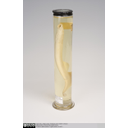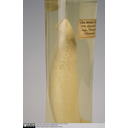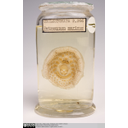Lamphreys
Petromyzontiformes - lampreys
| Vertebrata; Petromyzontiformes |


Diversity
and Lower Taxonomy:
The order Petromyzontiformes comprises
a single family, Petromyzontidae, containing 40 extant species of lamprey across ten genera: Petromyzon, Caspiomyzon, Geotria, Mordacia,Eudontomyzon, Tetrapleurodon, Entosphenus, Lethenteron,
and Lampetra.
Distribution and Habitat:
Lampreys inhabit either freshwater or marine environments in all temperate
regions except those of
Conservation Status (IUCN):
The IUCN Red List has assessment entries for only 18 of the 40 species of
lamprey. Of these, the majority (10 species) are listed as Least
Concern (LC). While one species, the Ukrainian migratory lamprey (Eudontomyzon sp. nov.
'migratory'), was confirmed extinct in 2008, another species, the
Greek Brook lamprey
(Eudontomyzon hellenicus), is Critically
Endangered (CR).
Two species are considered Near Threatened (NT) and one
is Vulnerable
(VU), while the remaining species are Data Deficient (DD).
Features:
- Lack a bony skeleton and jaws
(bones may have been secondarily lost, as there is evidence to suggest
that their ancestors possessed a bony skeleton).
- No paired fins (pectoral,
pelvic), but do have unpaired fins: dorsal
and caudal (tail) fin.
- Presence of horny teeth, which
they use as a "rasping tongue" to suck on to prey, and pierce
the flesh to draw blood.
- Rows of paired gill openings;
water flows in and out of the gills in a tidal flow - while most fish
breathe by drawing water into the mouth, past the gills, and out through
the gill slits in a one-way flow of water, lampreys cannot use their
mouths for ventilation as they are attached to prey!
Licensed under the Creative Commons Attribution Non-commercial Share Alike 3.0 License
'Vertebrate Diversity' has been released as an open educational resource (OER) on a Creative Commons 'Attribution Non-commercial Share Alike' license. This means that once downloaded, content can be modified and improved to complement a particular course. This requires, however, that improvements are recycled back into the OER community. All content present at the time of download must be accordingly credited and, in turn, novel content must be appropriately licensed. For more information, please refer to the license deed by clicking on the link above.


